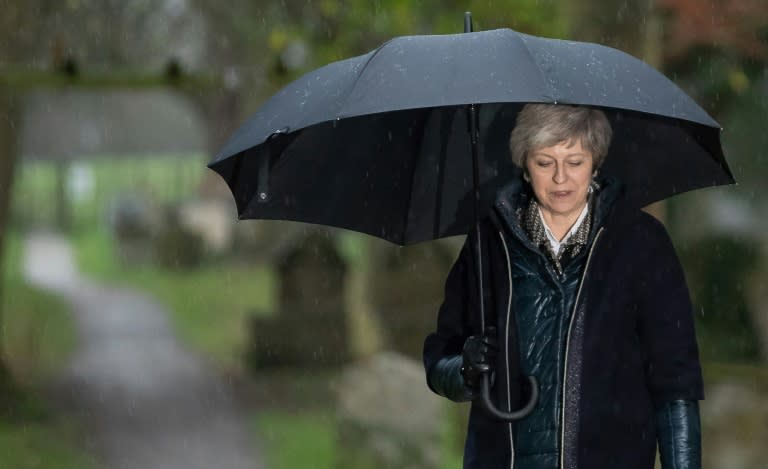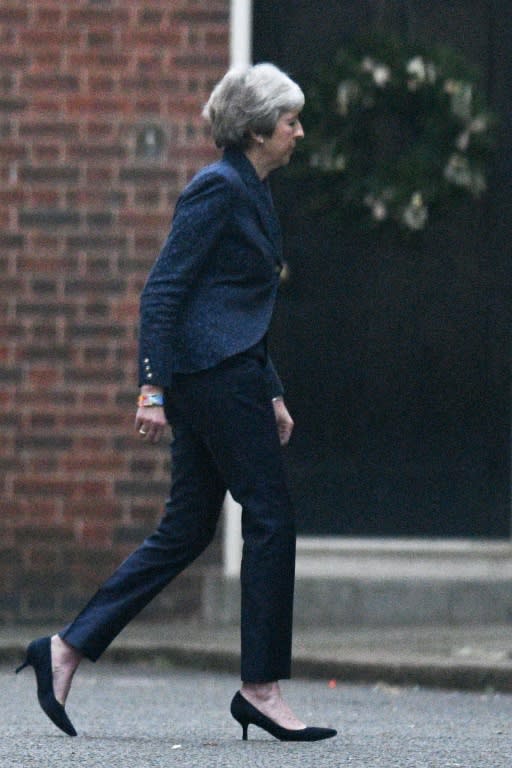UK's May ploughs on in historic Brexit mission
Theresa May has proudly adopted one Conservative grandee's dismissal of her as a "bloody difficult woman". The prime minister's obduracy is on full display as she heads fighting into a Conservative party confidence vote late Wednesday that will define not just her own future as leader, but Britain's Brexit destiny too. The Oxford-educated daughter of a vicar said she would contest the vote among Conservative members of parliament, forced by a number of dissident MPs, "with everything I've got". It was a typically defiant performance delivered outside 10 Downing Street, which she took over after her predecessor David Cameron walked out, hours after voters opted in June 2016 for Britain to exit the European Union. May herself campaigned in the referendum to remain in the EU. But she has since fought tenaciously to implement the voters' verdict against resistance from both those who think it was a terrible mistake, and the hardliners who want a clean break with the EU. She compares herself to her cricketing hero Geoffrey Boycott, who was a byword for doggedness as a batsman, and gleefully seized on the "bloody difficult" put-down delivered by party elder Kenneth Clarke. But May's perseverance has also been characterised as intransigence, not least in her adoption of inflexible "red lines" in the Brexit negotiations that critics say has led to the current impasse. She eschews gossip and networking, proving herself through hard work, spending six years in the tough job of home secretary (interior minister) before succeeding Cameron. Her reserved nature often makes for stilted relations with world leaders and voters. Her style of repeating the same phrases and avoiding direct questions has earned her another nickname in the media -- "Maybot". - 'Goody two shoes' - May, 62, described herself in a 2012 interview as a "goody two shoes" whose Protestant faith defined her upbringing. She listened to cricket matches on the radio with her father and knew she wanted to become a politician when she was just 12. May studied geography at the University of Oxford, where she met her husband Philip, a banker, after reportedly being introduced by future Pakistan premier Benazir Bhutto. The couple never had children and May devoted herself to a life of public service that saw her become Conservative Party chairwoman in 2002. She made her first splash by telling her Tories at an annual conference to stop being "the nasty party" if they wanted to unseat Labour leader Tony Blair. But her 2010-16 stint as home secretary saw May adopt isolationist rhetoric that included a vow to create "a really hostile environment for illegal migration". Yet May's own faith in a "great, global" Britain did not translate into a rejection of the EU as a whole. "Britain is too small a country to cope outside the European Union," she said in an April 2016 address. - 'Brexit means Brexit' - But Britons voted to split by a 52-48 margin and May took over from Cameron after winning the leadership contest with a vow that "Brexit means Brexit". It became her mantra -- a gritty determination to bear down and get the job done no matter the political cost. That job became immeasurably harder after May blundered into calling a snap June 2017 election that she hoped would bury domestic opposition to her Brexit plans. She ended up losing her majority and entering a forced marriage of convenience with Northern Ireland's fervently anti-EU Democratic Unionist Party. The DUP joined Tory hardliners along with many pro-EU MPs in opposing May's watered-down Brexit deal, negotiated arduously with Brussels, forcing her into the embarrassing step of postponing the withdrawal vote this week. But the prime minister remains adamant that the deal -- and her leadership -- is the best on offer. "Weeks spent tearing ourselves apart will only create more divisions," she said Wednesday. "I stand ready to finish the job."




